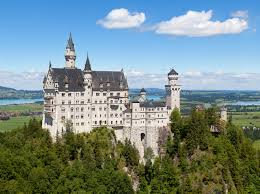Introduction
Nestled high in the Bavarian Alps, surrounded by rolling hills, sparkling lakes, and misty forests, Neuschwanstein Castle stands as one of the most enchanting and iconic landmarks in the world. Often referred to as the “Fairytale Castle” of Germany, it looks as if it were plucked straight from a storybook. Built by King Ludwig II of Bavaria in the 19th century, Neuschwanstein Castle is not just a masterpiece of romantic architecture—it’s a symbol of imagination, art, and the pursuit of beauty.
This article explores the history, architecture, and allure of Neuschwanstein Castle, revealing why it continues to captivate millions of visitors every year.
The Visionary Behind the Castle – King Ludwig II
The story of Neuschwanstein Castle begins with King Ludwig II, often called the “Mad King” or the “Dream King.” Ludwig ascended to the Bavarian throne in 1864 at the age of 18 and quickly developed a fascination with art, music, and medieval legends. Deeply inspired by the operas of his friend and composer Richard Wagner, Ludwig envisioned a grand retreat where fantasy and reality could merge.
In 1869, construction began on Neuschwanstein Castle, Ludwig’s ultimate dream project—a place where he could escape the burdens of royal life and immerse himself in a world of myth and beauty. Tragically, he never saw the castle completed. The king mysteriously died in 1886, and the castle remained unfinished, though its magic endures to this day.
Architecture and Design – A Romantic Masterpiece
Neuschwanstein Castle’s architecture is a breathtaking blend of Romanesque Revival, Gothic, and Byzantine styles. Designed by Christian Jank, a theatrical set designer rather than a traditional architect, the castle was created as a fantastical interpretation of a medieval knight’s fortress.
Exterior Grandeur
Perched atop a rugged hill near Füssen, the castle features soaring towers, pointed spires, and a gleaming white limestone façade. Its turrets and balconies overlook the lush Hohenschwangau Valley, creating a view so magical that it later inspired Walt Disney’s Sleeping Beauty Castle.
Interior Wonders
Inside, every room is a work of art. The Throne Hall, influenced by Byzantine churches, dazzles with golden mosaics, marble pillars, and a massive chandelier symbolizing the heavens. The Singer’s Hall, modeled after the Wartburg Castle, celebrates medieval romance and music with intricate murals and a vaulted wooden ceiling.
The castle also includes modern innovations for its time—central heating, running water, and even an early version of a telephone system, reflecting Ludwig’s appreciation for both art and technology.
A Fairytale Setting in Bavaria
Neuschwanstein Castle’s setting adds to its ethereal charm. Located in southwest Bavaria, near the village of Hohenschwangau, the castle is surrounded by the picturesque Alpsee Lake and dense alpine forests. The snow-capped peaks of the Ammergau Alps create a dramatic backdrop that enhances the castle’s dreamlike aura.
Visitors often hike up from the village or take a scenic carriage ride through the forest, making the approach feel like a journey into a fairy tale. From the nearby Marienbrücke (Mary’s Bridge), breathtaking panoramic views of the castle and the valley unfold—a photographer’s paradise.
Neuschwanstein Castle and Walt Disney
Neuschwanstein’s beauty transcends borders and time. When Walt Disney visited Europe in the 1950s, he was so inspired by its romantic silhouette that he used it as the model for Sleeping Beauty’s Castle in Disneyland. Since then, Neuschwanstein has become synonymous with fairy tales, magic, and happily-ever-afters.
Its influence is also evident in films, artwork, and video games, cementing its place as one of the world’s most recognizable and beloved castles.
Tourism and Global Appeal
Today, Neuschwanstein Castle is one of the most visited tourist attractions in Germany, drawing over 1.5 million visitors annually. The castle’s charm lies not only in its architectural splendor but also in the romantic story of its creator—a king who chose dreams over duty.
Visitor Experience
Guided tours take visitors through lavish rooms, telling stories of Ludwig’s life, artistic passions, and mysterious death. The journey offers a glimpse into his world of music, mythology, and solitude.
Each season offers a unique atmosphere:
-
Spring brings blooming valleys and crystal-clear lakes.
-
Summer bathes the castle in golden sunlight.
-
Autumn surrounds it with fiery red and orange foliage.
-
Winter transforms it into a snow-covered wonderland straight out of a fairy tale.
Sustainable Tourism
German authorities have taken steps to preserve the castle’s delicate structure and environment, ensuring that future generations can continue to experience its magic responsibly.
Symbolism and Legacy
Beyond its beauty, Neuschwanstein represents freedom, imagination, and artistic expression. King Ludwig II built it not for political power or defense, but as a personal refuge from reality—a monument to creativity and passion.
Though critics once dismissed Ludwig as eccentric, history now celebrates him as a visionary dreamer whose legacy lives on through art, architecture, and fantasy. Neuschwanstein stands as a timeless reminder that imagination can build worlds as real as any stone fortress.
How to Visit Neuschwanstein Castle
If you plan to explore this fairytale fortress in person, here’s what you need to know:
-
Location: Schwangau, near Füssen, Bavaria, Germany
-
Opening Hours: Usually from 9:00 AM to 6:00 PM (varies by season)
-
Tickets: Must be reserved in advance through the official website or the ticket center in Hohenschwangau.
-
Getting There: Easily accessible by train or car from Munich (approximately 2 hours). From Füssen, buses and horse-drawn carriages can take you to the castle gates.
For the best photos, visit Marienbrücke, the bridge behind the castle—it offers the most iconic viewpoint.
Conclusion
Neuschwanstein Castle, Germany – The Fairytale Fortress, is more than just a tourist destination—it’s a dream carved in stone. From its visionary creator, King Ludwig II, to its awe-inspiring design and cinematic influence, every element tells a story of wonder and imagination.


You must be logged in to post a comment.